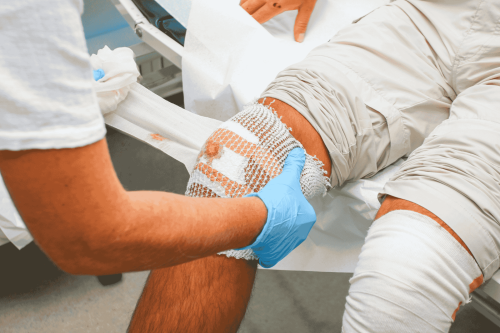Patients don’t just benefit from great teamwork—they notice it. According to American Hospital Association, when patients perceive their care as safe, they are 2.5 to 3 times more likely to recommend the hospital to others. These perceptions are shaped not just by the medical treatment they receive, but by what they observe—cleanliness, hand hygiene, and how well the care team communicates and works together. When teamwork is seamless, care is safer, more efficient, and more compassionate. But when communication breaks down or silos form, mistakes happen—and patients feel the difference. This is why team building is a highly effective strategy for better care. Let’s explore five proven team building strategies that healthcare leaders are using today to boost collaboration and elevate patient outcomes.
How Team Building Drives Better Patient Outcomes: 5 Strategies That Work

Interdisciplinary Training: Practicing Together to Perform Better
Imagine a code blue scenario where every second counts. When doctors, nurses, and respiratory therapists have trained together, they respond as one cohesive unit. That’s the power of interdisciplinary training.
This approach brings different roles together to practice clinical scenarios as a team. By simulating real-life emergencies or routine procedures, staff learn each other’s communication styles, roles, and expectations.
Why it works:
- Reduces confusion during high-stakes moments
- Builds mutual respect between departments
- Reinforces clear role definitions and responsibilities
Pro tip: Start with quarterly simulations or shared workshops that involve multiple disciplines. Even practicing handoff communication between nurses and physicians can reduce errors and delays in care.
Regular Team Huddles: Small Talks, Big Impact
Team huddles are short, focused meetings—often held at the start of a shift. These five- to ten-minute check-ins can dramatically improve communication and reduce errors.
During a huddle, teams can:
- Review patient updates
- Flag any concerns
- Clarify responsibilities
- Celebrate small wins
Though brief, these moments help staff feel connected and aligned. They reduce assumptions and promote a sense of shared accountability for every patient.
Why it works:
- Keeps everyone on the same page
- Encourages proactive problem-solving
- Promotes psychological safety and open communication
Pro tip: Keep huddles consistent and agenda-driven. Even virtual or hybrid teams can use this model via quick video calls.
Peer Mentorship: Growing Together, Learning Together
When new team members join, they often face a steep learning curve—not just in clinical knowledge, but in navigating workplace culture, team dynamics, and unwritten norms.
That’s where peer mentorship comes in.
Pairing new employees with seasoned mentors fosters trust, improves retention, and helps build stronger teams from day one. It also provides a space to ask questions, share concerns, and receive feedback in a safe environment.
Why it works:
- Accelerates team integration and reduces burnout
- Builds leadership capacity among experienced staff
- Encourages a learning-oriented workplace culture
Pro tip: Mentorship doesn’t have to be formal. Encourage “buddy systems” or peer partners within departments to build natural support networks.
Conflict Management Training: Turning Tension Into Teamwork
Healthcare is a high-pressure environment. Long hours, emotional stress, and complex decisions can lead to tension—even among the best teams. Left unaddressed, that tension can affect communication, morale, and ultimately, patient care.
That’s why conflict management training is essential. It helps staff:
- Recognize early signs of conflict
- Communicate clearly and respectfully
- Resolve issues without blame or escalation
When team members feel confident navigating conflict, they’re more likely to speak up, share ideas, and collaborate—even when challenges arise.
Why it works:
- Prevents breakdowns in communication
- Builds trust and reduces workplace drama
- Fosters a culture of accountability and respect
Pro tip: Integrate conflict resolution scenarios into annual training. Role-play exercises and open discussions can make training more relatable and impactful.
Celebrating Wins and Recognizing Effort
One of the simplest—and most overlooked—team building strategies is celebrating success. Whether it’s a well-coordinated discharge, a life-saving intervention, or just a day without any missed documentation, recognition reinforces teamwork and motivation.
Healthcare teams are often so focused on what went wrong, they forget to acknowledge what went right. But when staff feel appreciated, their job satisfaction—and performance—rises.
Why it works:
- Boosts morale and reduces burnout
- Reinforces positive behaviors and habits
- Encourages a culture of appreciation and teamwork
Pro tip: Use monthly shout-outs, bulletin boards, or team emails to recognize efforts. Encourage peer-to-peer appreciation, not just top-down recognition.
Why This Matters: The Bottom Line
Team building isn’t about icebreakers or trust falls. It’s about saving lives more effectively.
When teams are aligned, patients benefit. Studies show that better team communication leads to:
- Lower rates of medical errors
- Improved patient satisfaction
- Faster treatment decisions
- Higher staff retention and engagement
In short, investing in your team is an investment in your patients.
Final Thoughts: Building Better Teams, One Step at a Time

Improving patient outcomes doesn’t always require new technology or more staff. Sometimes, the biggest impact comes from building stronger relationships among the people you already have.
By implementing these five team building strategies, healthcare providers can create more connected, resilient, and high-performing teams—and in turn, provide better, safer, and more compassionate care.
Ready to take the next step?
Ensure compliance, boost operational efficiency, and build lasting trust within your team through targeted training. Enroll your large team in our customized, free course development program today—designed specifically for healthcare providers who want to invest in their people and their patients.
Let’s build stronger teams, together. Click here.



